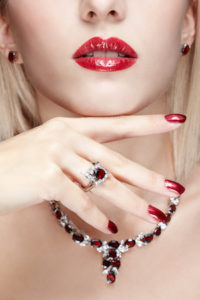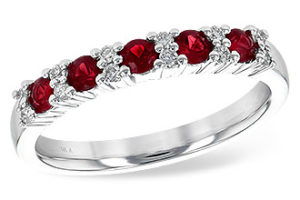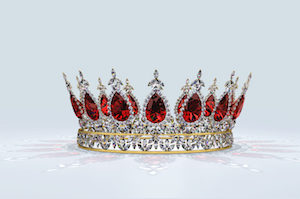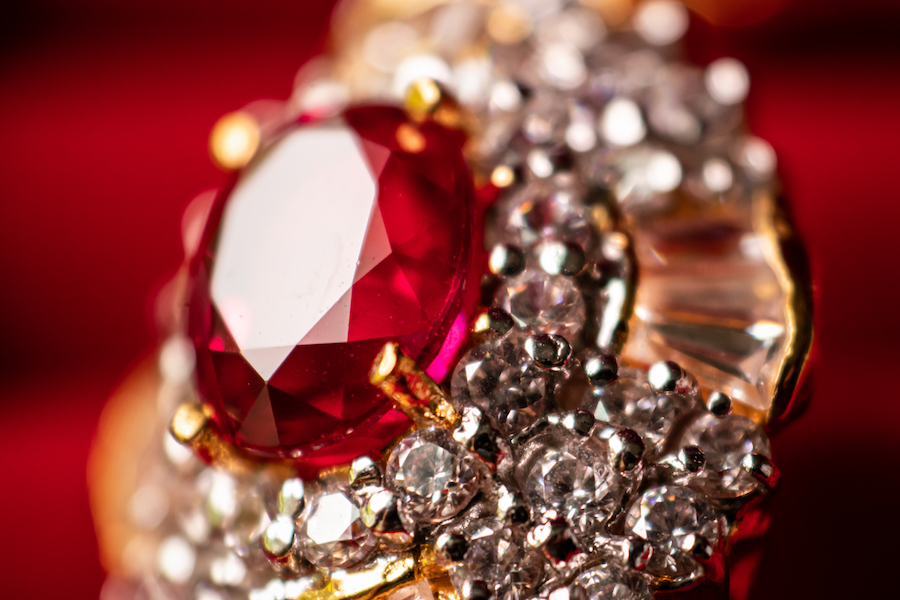Rubies are gems with predominantly red color. The most desirable color range is a pure vibrant red to a slightly purplish red. But they can range from orangy red to purplish red or brownish red. Rubies have a combination of color and clarity that makes them an attractive gem.
Rubies are made of corundum. Corundum comes in many other colors, but those colors are classified as sapphires. Pink corundum is sometimes referred to as pink sapphire. But other times is referred to as pink ruby depending on the hue, region, and personal opinion. Ruby gets its red coloring from trace amounts of chromium.
Where Are They Found?
The world’s largest supplier of rubies is Myanmar, where 90% of the world’s rubies come from. Other sources are Sri Lanka, Thailand, Cambodia, and Afghanistan.
Myanmar
Myanmar is the world’s ruby capital with more than 90% of the world’s rubies coming from the Asian nation. The country is also home to world’s largest cut ruby which weighs at 1,184  carats. Myanmar’s government is in possession of a sizeable uncut ruby weighing 500 carats. Rubies are among the most important exports from Myanmar. Most of the ruby mining in Myanmar takes place in the nation’s mountainous Mogok area which has mines with large ruby deposits. Official exports of rubies from the country are valued at over $87.4 million while the undocumented exports are possibly more.
carats. Myanmar’s government is in possession of a sizeable uncut ruby weighing 500 carats. Rubies are among the most important exports from Myanmar. Most of the ruby mining in Myanmar takes place in the nation’s mountainous Mogok area which has mines with large ruby deposits. Official exports of rubies from the country are valued at over $87.4 million while the undocumented exports are possibly more.
Sri Lanka
Sri Lanka is another country where a lot of rubies are sourced. As a testament of the country’s substantial ruby deposits, Sri Lanka is also known as “Ratna Dweepa” which translates to “Gem Island.” The island’s rubies are notable for their lighter color. Scientists estimate that about 25% of the nation’s landmass has the potential of bearing rubies. Most of the ruby mining is carried out in Ratnapura, a city whose name means “City of the Gems.” The large ruby deposits found in the country is attributed to its ancient geological history. Sri Lanka sits on some of the oldest rocks on earth which date back to the Precambrian epoch.
Afghanistan
Rubies and other gemstones have been mined in Afghanistan for thousands of years since the Neolithic Era. The rubies mined in Afghanistan are renowned for their high quality. Up to 95% of the country’s gemstones (including rubies) are smuggled to Peshawar, a city in neighboring Pakistan. The illegal trade of the gemstones makes it hard to establish the value of rubies produced in Afghanistan.
Cambodia and Thailand
The ruby deposits in Cambodia have been exploited for centuries. However, the locals do not have a name for rubies and refer to them as “ksath rung” which translates to “hard flesh.” This term refers to both rubies and sapphires.
Thailand is another nation known for its abundance of rubies. The country is, however, infamous for being the destination for most of the smuggled rubies from its neighboring countries. After arriving in Thailand, the smuggled rubies are polished and cut and later sold to western markets. Thailand is also home to countless scammers who sell fake rubies to unsuspecting buyers. The nation’s capital, Bangkok is particularly notorious for its ruby scammers.
Other Locations
The United States also has some ruby deposits. Rubies have been found in the states of North Carolina, Montana, Wyoming, and South Carolina.
What Are They Worth?
High-quality rubies that weigh over 10 carats can sell for much more than a similar-sized diamond. Some large rubies have fetched sale prices upwards of $225,000 per carat. Comparably sized diamonds average a sales price of around $125,000 per carat. Rubies of this magnitude are significantly more rare than larger sized diamonds, which explains the difference in price.
The most desirable shade of ruby is a deep red with a hint of blue which is referred to as “pigeon’s blood.”
Inclusions (or imperfections) in rubies are to be expected and are generally well tolerated. However, when inclusions impact the transparency or brilliance of the stone, the value of the ruby dramatically decreases.
Many top-quality rubies have been mined in Myanmar (formerly Burma), which is where the term “Burmese ruby” comes from.
History and Lore
Rubies symbolize power and protection. When worn as a talisman, ruby was believed to help protect warriors in battle. One more modern allusion to this legend is in The Wizard of Oz. Dorthy’s ruby slippers were thought to protect her from evil.
Rubies are referenced four different times in the bible. The Bible associates these gems with beauty and wisdom.
According to ancient folklore, people of India believed rubies would help them be at peace with their enemies.
Thailand is one of the leading hubs for ruby mining and production, with other leading countries including Madagascar, Sri Lanka, and India.
Religious References
Rubies are mentioned four times in the Bible and were said to be the most precious of the 12 stones created by God. Hindus called rubies ‘Ratnaraj’, meaning ‘king of the precious Gems’, and later ‘ratnanayaka’, meaning ‘leader of all precious stones’. In the Harita Smriti, it is written that ‘He who worships Krishna with Rubies will be reborn as a powerful emperor’.
Rubies will be reborn as a powerful emperor’.
Rubies and Health
Rubies have also been associated with blood. Among Burmese soldiers, it was believed that wearing a Ruby on the left would make the wearer invincible. This belief was so strong that some soldiers inserted Rubies into their flesh under the skin. They then were believed to be safe from wounds, and were said to be very fierce in battle as well.
The idea that Rubies protected from wounds had a flip side as well. Soldiers believed that Ruby bullets would inflict more harm. There are instances of this belief as late as the early 1900s.
Famous Rubies
Until the beginning of the 19th century, red spinels were thought to be rubies. Famous stones including “Black Prince’s Ruby” and “Timur Ruby” were considered to be rubies until it was discovered that they and many other red stones were, in fact, red spinels.
Some famous rubies include the “Rosser Reeves Star Ruby,” the “Edwardes Ruby,” and the “De Long Star Ruby”
In 2011, an 8.24-carat ruby ring belonging to Elizabeth Taylor and made by Van Cleef & Arpels sold at auction for $4.2 million, with the price per carat amounting to approximately $500,000.
The most expensive ruby ever sold was the “Hope Ruby” which weighs 32.08 carats and sold for $6.74 million.
An Emotional Gem
Red is the color of our most intense emotions—love and anger, passion and fury. It’s associated with objects of power and desire—like fast cars and red roses. Early cultures treasured rubies for their similarity to the redness of the blood that flowed through their veins, and believed that rubies held the power of life.
Rubies are one of the most historically significant colored stones. Rubies are mentioned four times in the Bible, in association with attributes like beauty and wisdom. In the ancient language of Sanskrit, ruby is called ratnaraj, or “king of precious stones.”
In the first century AD, the Roman scholar Pliny included rubies in his Natural History. He described their hardness and density. Ancient Hindus believed that those who offered these gemstones to the god Krishna were granted rebirth as emperors.
Hindus divided ruby into four castes, calling the true Oriental ruby a Brahmin. Someone in possession of a Brahmin was believed to have the advantage of perfect safety.
Rubies in Battle
Rubies have accumulated a host of legends over the centuries. People in India believed these stones enabled their owners to live in peace with their enemies. In Burma (a ruby source since at least 600 AD—now called Myanmar), warriors possessed rubies to make them invincible in battle. However, it wasn’t enough to just wear them. They had to insert them into their flesh and make them part of their bodies.
The name ruby comes from the Latin word ruber, which means “red.” The glowing red of ruby suggested an inextinguishable flame burning in the stone, even shining through clothing and able to boil water.
able to boil water.
These stones have been called the most precious of the 12 stones created by God.
Rubies and Royalty
Medieval Europeans wore rubies to guarantee health, wealth, wisdom, and success in love. Ruby retained its importance with the birth of the western world and became one of the most sought-after gems of European royalty and the upper classes.
Consumers are drawn to the lush color because it also signifies wealth and success. Desire for this gemstone continues to be popular. Because they are a symbol of passion, a ruby makes an ideal romantic gift.
Synthetic Rubies
Synthetic “flame-fusion” rubies hit the commercial market in the late 1800s. Chemist Auguste Verneuil perfected this method and had his ruby material shown at the Paris World’s Fair in 1900.
Most modern rubies are treated to improve their color and durability. Treatments include heat treatment, irradiation, and fracture filling. All treatments should be disclosed to the buyer.
The first-ever functional laser was created with a synthetic ruby crystal by Theodore H. Maiman in 1960. Synthetic rubies are used not only in laser technology but also in microelectronics.

